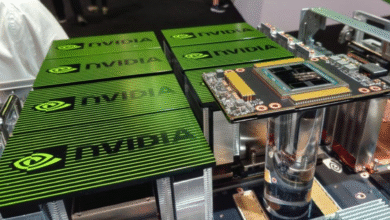TSMC: Nvidia’s Key Player in AI and Semiconductor Growth
Taiwan Semiconductor Manufacturing Co. (TSMC) stands at the forefront of the global semiconductor industry, earning accolades from leaders like Nvidia CEO Jensen Huang. During a recent visit to Taiwan, Huang lauded TSMC as one of humanity’s greatest companies, illustrating its pivotal role in the tech landscape. As artificial intelligence technology surges in popularity, TSMC’s contributions to next-generation AI chip architecture are becoming increasingly vital. With projects like the development of Nvidia’s Rubin chip architecture, TSMC is cementing its status as a key player in advancing AI capabilities. As the U.S. government looks to strengthen its semiconductor supply chain through initiatives like the CHIPS Act, TSMC is poised to receive significant investments to expand its manufacturing base in Arizona and beyond.
The prominence of Taiwan Semiconductor Manufacturing Co. (TSMC) cannot be understated in the context of the modern electronics landscape. Often hailed as a cornerstone of the semiconductor manufacturing sector, TSMC supplies critical components that power leading technologies across the globe. With the surge in AI innovations, companies like Nvidia are reliant on TSMC’s cutting-edge fabrication techniques, which enable the production of highly sophisticated chips. As TSMC continues to expand its capabilities, particularly in the face of increasing geopolitical challenges, its strategic importance to both tech giants and national policies alike remains evident. This narrative reflects broader trends within the technology domain, where collaboration and innovation are paramount.
The Significance of TSMC in the Semiconductor Industry
Taiwan Semiconductor Manufacturing Co. (TSMC) stands as a pillar in the semiconductor industry, significantly impacting global technology supply chains. With advanced fabrication processes and unparalleled manufacturing capabilities, TSMC produces chips for renowned companies like Nvidia. This strategic collaboration has cemented TSMC’s reputation, especially as demand for AI technology continues to rise. The acknowledgment by industry leaders, such as Nvidia’s Jensen Huang, reflects TSMC’s crucial role in delivering cutting-edge products that drive innovation across various tech sectors.
The semiconductor industry’s evolution has increasingly spotlighted TSMC’s role in advancing technology. Huang’s belief in TSMC as one of the greatest companies aligns with the global appreciation of its innovations. The United States’ recent interest in investing in semiconductor firms, including TSMC, further underlines the importance of maintaining a robust supply chain. As AI technology integration spreads through consumer electronics to cloud computing, TSMC’s contributions become even more vital, ensuring that companies like Nvidia can lead in innovation and profitability.
Nvidia’s Collaboration with TSMC on AI Technology
Nvidia’s partnership with TSMC exemplifies a successful collaboration in the development of advanced AI technology. Recently, Jensen Huang highlighted TSMC’s contributions to creating Nvidia’s next-generation AI chip architecture, known as Rubin. This partnership not only accelerates the pace of innovation but also allows both companies to leverage their strengths in the semiconductor domain effectively. TSMC’s ability to manufacture complex chips enables Nvidia to push the boundaries of what is possible in AI applications, strengthening their market position against competitors.
Moreover, TSMC is tasked with developing six new products for Nvidia, including a central processing unit (CPU) and a graphics processing unit (GPU), both designed to enhance AI capabilities. This relationship signifies a pivotal moment in the tech landscape, as the need for powerful, efficient, and scalable AI solutions becomes increasingly apparent. The advancements resulting from TSMC’s fabrication technologies are set to redefine industries, underscoring the inseparable bond between these two titans of technology within the semiconductor industry.
The Impact of Government Initiatives on TSMC and Nvidia
The U.S. government’s strategic initiative, known as the CHIPS Act, aims to fortify domestic semiconductor production, highlighting the significance of companies like TSMC and Nvidia in national security and economic stability. With TSMC slated to receive $6.6 billion for constructing advanced facilities in Arizona, the initiative represents a broader commitment to sustainable tech development. This investment not only bolsters TSMC’s manufacturing capabilities but also positions Nvidia to benefit from enhanced local production of crucial components.
Nvidia’s recent expansions in Taiwan and the U.S. resonate with the proactive steps being taken to ensure a resilient semiconductor supply chain. Huang’s optimism about securing partnerships with local suppliers and engineers emphasizes the interconnectedness of tech innovation and government policies. By enhancing collaboration within the semiconductor industry, these initiatives can enable companies like Nvidia and TSMC to respond more effectively to growing demands and geopolitical tensions, particularly in Asia.
Addressing Geopolitical Challenges in China’s Semiconductor Market
In light of the escalating geopolitical tensions, especially with China, Nvidia faces unique challenges in its operations, including the production of H20 graphics processors. Huang remains optimistic about navigating these complexities, as the semiconductor industry grapples with stringent export regulations and market access issues. The potential need for export licenses for certain products reflects the intricate balance between technological advancement and international relations, particularly as companies like Nvidia strive to comply with evolving government stipulations.
As local Chinese companies face restrictions on purchasing Nvidia’s products, this situation presents both challenges and opportunities for Nvidia. Huang’s foresight suggests that the resolution of these issues is not only vital for maintaining market presence but also for ensuring that the innovations brought about through partnerships with manufacturers like TSMC are not compromised. The cooperative approach to handling these geopolitical factors augurs well for Nvidia’s long-term strategies, underlining the importance of adaptability in the semiconductor industry.
Jensen Huang’s Vision for Nvidia’s Future in AI
Jensen Huang’s recent remarks during his visit to Taiwan indicate a clear vision for Nvidia’s future, especially regarding advancements in AI technology. His recognition of TSMC’s pivotal role illustrates the interconnected ecosystem of tech development where semiconductor innovations directly influence AI capabilities. Huang’s commitment to nurturing these relationships not only enhances Nvidia’s product offerings but also establishes the company as a leader in the burgeoning AI sphere, with TSMC as a steadfast partner.
Furthermore, Huang’s insights reveal a forward-thinking approach to Barry future opportunities within AI applications. By investing in cutting-edge chip architectures and fostering local collaborations, Nvidia aims to position itself at the forefront of technological disruption. His confidence in TSMC as an essential factor in Nvidia’s growth strategy underlines the importance of their collaboration in addressing the growing demands of AI and machine learning across various industries.
The Role of TSMC in Nvidia’s Growth Strategy
TSMC plays a crucial role in Nvidia’s growth strategy, providing the semiconductor backbone for its most innovative products. With their advanced manufacturing capabilities, TSMC enables Nvidia to produce high-performance chips that meet the increasing computational demands of modern applications, particularly in the field of artificial intelligence. The collaboration between these two tech giants underscores how vital TSMC is in helping Nvidia maintain its competitive edge in the fast-paced semiconductor market.
Through their partnership, Nvidia and TSMC are positioned to capitalize on the surging demand for AI technology. TSMC’s commitment to developing new products, including CPUs and GPUs tailored for AI enhancement, aligns perfectly with Nvidia’s vision of pushing the envelope in computational performance. This synergy not only fosters innovation but also propels both companies toward achieving their business objectives as leaders in the semiconductor industry.
The Future of Semiconductor Manufacturing in Taiwan
Taiwan, particularly through TSMC, is poised to remain a dominant force in semiconductor manufacturing, driving global technological advancements. As companies like Nvidia continue to rely on TSMC’s cutting-edge fabrication processes, the island’s significance in the semiconductor industry will likely grow. Huang’s acknowledgment of TSMC’s influence reflects a shared vision amongst industry leaders regarding Taiwan’s pivotal role in shaping the future of technology, particularly in AI.
Moreover, as the global economy increasingly hinges on technology, Taiwan’s strategic importance in semiconductor manufacturing is underscored by investments from both local and international companies. The TSMC-led advancements are not only meant to enhance local capabilities but also to ensure that Taiwan remains competitive on the world stage. This drive for innovation and excellence positions Taiwan as a critical hub in the semiconductor supply chain, influencing tech developments worldwide.
Nvidia’s Strategic Investments in Taiwanese Talent
Nvidia’s commitment to investing in Taiwan’s local talent is part of a larger strategy to harness the expertise and innovation within the semiconductor landscape. With the establishment of ‘NVIDIA Constellation’, Huang aims to create an environment that fosters collaboration amongst local engineers and suppliers, solidifying Nvidia’s operational capacity within Taiwan. This strategy emphasizes the importance of local knowledge in enhancing Nvidia’s product development processes and overall competitiveness in a rapidly evolving market.
Furthermore, as TSMC continues to innovate within Taiwan, Nvidia’s investments in local talent will be paramount for driving future advancements in AI technology. By leveraging the skills of Taiwanese engineers and forming strong bonds with local suppliers, Nvidia is ensuring that it remains at the forefront of AI developments. This mutual growth fosters a sustainable ecosystem where both Nvidia and TSMC can thrive, further securing Taiwan’s position in the global semiconductor industry.
Collaboration Beyond Borders: Nvidia and TSMC’s Global Impact
The collaboration between Nvidia and TSMC transcends geographic boundaries and has a global impact on the semiconductor industry. As both companies push the envelope in chip design and manufacturing, their partnership not only influences technological advancements in Taiwan but also sets industry standards worldwide. Huang’s comments during his visit underscore the significance of their collaboration and its role in redefining AI capabilities through innovative semiconductor solutions.
Moreover, as they introduce new technologies, this partnership is indicative of the broader trend of globalization in the semiconductor sector. Both companies play pivotal roles in shaping market dynamics as they navigate international challenges and opportunities. The resulting advancements not only enhance their competitiveness but also contribute to the overall advancement of technology on a global scale, reinforcing the significance of such partnerships in the modern economy.
Frequently Asked Questions
What is TSMC and why is it considered a leader in the semiconductor industry?
Taiwan Semiconductor Manufacturing Co. (TSMC) is a global leader in the semiconductor industry, renowned for its advanced manufacturing capabilities. The company plays a crucial role in developing cutting-edge technology, including Nvidia’s AI chip architecture. TSMC’s innovative processes and ability to produce high-performance chips make it one of the most respected companies in technology.
How does TSMC impact Nvidia’s AI technology development?
TSMC significantly impacts Nvidia’s AI technology development by manufacturing critical components used in Nvidia’s products. Recently, TSMC has been working on six new products for Nvidia, including advanced central processing units (CPUs) and graphics processing units (GPUs) that bolster AI capabilities, thereby enhancing performance in AI applications.
Why did Jensen Huang praise TSMC during his visit to Taiwan?
Jensen Huang, CEO of Nvidia, praised TSMC during his visit to Taiwan, calling it one of the greatest companies in history. He highlighted TSMC’s essential role in the progress of Nvidia, particularly in developing its next-generation AI technologies, and emphasized the company’s crucial contributions to the semiconductor industry as well.
What financial support is TSMC receiving to expand its operations in the U.S.?
TSMC is set to receive significant financial support amounting to $6.6 billion to assist in the construction of three state-of-the-art semiconductor fabrication facilities in Arizona. This investment aims to enhance domestic semiconductor production in line with the U.S. government’s CHIPS Act objectives.
What are the geopolitical challenges TSMC and Nvidia are facing in relation to China?
TSMC and Nvidia are navigating geopolitical challenges, particularly regarding production limitations and export licensing for specific products like Nvidia’s H20 graphics processors in China. These challenges arise from security concerns and local regulations, which impact their operations and market dynamics.
How is Nvidia expanding its presence in Taiwan with the help of TSMC?
Nvidia is expanding its presence in Taiwan by developing a new office called ‘NVIDIA Constellation’ to support its growing workforce. This expansion is bolstered by TSMC’s collaboration in semiconductor manufacturing, ensuring that Nvidia has access to top-tier technology and local suppliers.
What role does TSMC play in the U.S. semiconductor industry’s growth under the CHIPS Act?
Under the CHIPS Act, TSMC plays a pivotal role in the growth of the U.S. semiconductor industry by establishing new fabrication plants and increasing domestic production capabilities. This initiative is designed to reduce dependency on foreign semiconductor supply, thereby enhancing national security and technological independence.
| Key Point | Details |
|---|---|
| Praise for TSMC | Nvidia CEO Jensen Huang hailed TSMC as one of the greatest companies in history, benefiting major investors. |
| Role in Nvidia | TSMC is crucial to Nvidia’s next-gen AI chip architecture, Rubin, and is developing six new products, including a CPU and GPU. |
| U.S. Government Interest | The U.S. is considering investments in chip firms like TSMC under the CHIPS Act, aiming to enhance semiconductor production. |
| Financial Support for TSMC | TSMC is to receive $6.6 billion for building fabrication facilities in Arizona. |
| Nvidia’s Expansion | Nvidia is expanding its presence in Taiwan with a new office, the ‘NVIDIA Constellation,’ to support its workforce. |
| Geopolitical Challenges | Nvidia is adapting to geopolitical tensions affecting production and sales of its products in China. |
Summary
TSMC plays a pivotal role in the semiconductor industry, and Nvidia CEO Jensen Huang highlights its immense value to both tech firms and investors. With significant government interest and investment intentions towards TSMC, the company’s advancements in AI technologies mirror the broader trend of innovation in the tech landscape. As companies navigate geopolitical challenges, TSMC’s continued growth and collaboration remain vital for sustaining high-performance computing and AI capabilities, reinforcing its status as a leader in the semiconductor industry.




